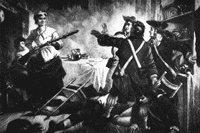The History of Traveler's Rest by Mildred W. Goodlett (1966)
copied at
Greenville County Library 10/20/82
The upper part of South Carolina, of which Greenville County and Travelers
Rest are a part, has been an exceptionally beautiful section of our country
of America since the earliest times. Its rolling hills, mountain scenery,
delightful climate, unsurpassed clear, cold mountain water make it one of
the garden spots of the world.
Its abundance of wild game in the deep forest and along the clear streams
made it a favorite hunting ground of the Indians before the advent of the
white man. Creek and Catawba as well as Cherokee tribes peopled the state,
but the Cherokee nation was the dominant one in the northwest part of the
state. This tribe, incidentally, was never defeated by another Indian
tribe.
Until the Revolution, what is now Greenville County remained a part of the
Cherokee Nation. In the year 1755 a treaty had been entered into between
Governor Glenn of South Carolina and the Cherokee chiefs, by which they
ceded part of their land to the white people. The Cherokees kept the land
on the west side of the old Indian Boundary Line between Spartanburg and
Greenville Counties which included Anderson, Pickens, Greenville, and Oconee
Counties and embraced the vicinity of Travelers Rest. In 1776 the Indians
were driven out and during the following year signed a treaty ceding the
present Greenville County lands to the state of South Carolina. ..........
The Indians and the few early white settlers had lived in comparative
friendship in the early years..... The white settlers had built a few forts
and a group of rough people called cow drivers transported these furs to
Augusta down old Augusta Road and to Charles Town and drove their herds of
horses and cattle along the Indian trails which led into the rough roads
which connected the settlements and trading posts. One such trading post
was the one established by Richard Pearis at the falls of Reedy River in the
present city limits of Greenville and is credited with being the first white
trading post in this section.
On account of the Revolutionary War, no steps were taken to open up the
lands newly acquired from the Indians, but by 1784 several thousand
immigrants from Virginia, Pennsylvania, and the lower part of the state had
advanced into the up country as well as many from across the old Boundary
Line in Spartanburg District. In this year of 1784 many land grants were
made in this part of the state mainly to those who had participated in the
Revolution. Record of these land grants and of plats of the same are to be
found in the court house in Greenville. Among these grants are some on
Enoree and Reedy Rivers which are near the Travelers Rest area. Among older
families receiving grants or making very early purchases were Howard, Dill,
Earle, Winn, Hopkins, Goodlett, Anderson, Stiles, Springfield, Benson,
Coleman, Smith, Langston, Bradley, Montgomery, Roe, Watson, Williams,
Morgan, McElhaney, Bradley, Cleveland, Edwards, McCauley, Batson, Prince,
Tubbs.
Among these early settlers was Thomas Springfield who lived near Travelers
Rest. He married Dicey Langston, Revolutionary War heroine, and they made
their home about two miles from Travelers Rest almost directly across the
road from Enoree Baptist Church. Dicey is buried in an old family grave
yard a short distance away.
During the Revolutionary War, Dicey, daughter of Solomon Langston, lived
across the Enoree River. This section was at times over run by the Tories
and was sometimes isolated from Whig protection. Dicey, then a young girl,
warned the Whig soldiers against planned attacks on several occasions and
saved the lives of many, her brothers among them. She also saved her
father's life later on.
(On page 11) The Major Lynch place was one of the very early stopping or
resting places for travelers by foot, horse back or stage coach. Maj. Henry
Ellis Lynch came from the Charleston area. (He is said to have been of the
family line of Thomas Lynch, Jr. of Charleston, one of the 4 signers of the
Declaration of Independence from South Carolina.) He bought 120 acres of
land at the corner of Asheville and Tigerville Roads from James Springfield,
son of Dicey Langston and Thomas Springfield, on October 9, 1829--Deed is on
file in Book Q, page 221 at the Greenville Court House.
(On page 12 (I think; it's not shown) Aquilla Bradley married Polly Turner
and their children were Betty, Hiram, Serepty, who married Moses Batson,
Smith, who married Jane Greene, Austin, Catherine, who married Solomon
Springfield, Mary, and Curtis, who married Minerva Montgomery. From the
Curtis Bradley family comes the families of Arnoldus Bradley, father of Mack
and Della Bradley and Mary, who married Andrew Jackson Gilreach and they
were parents of Lizzie (Mrs. William Turner), whose children are Sterling,
Hardy, Nan Dickens, Mollie Cason, and Neva.

